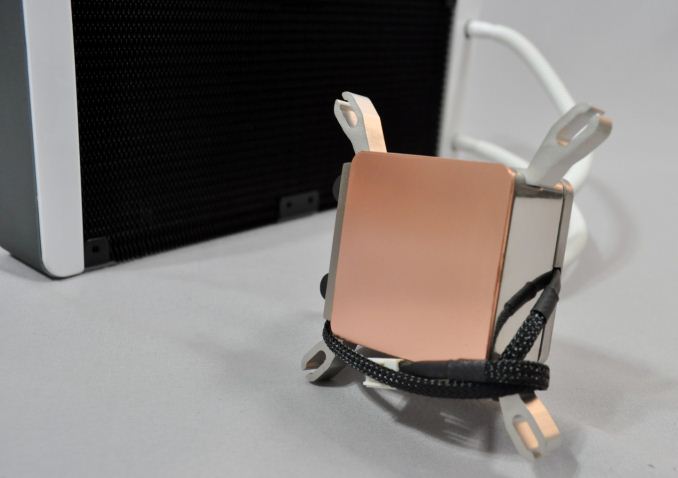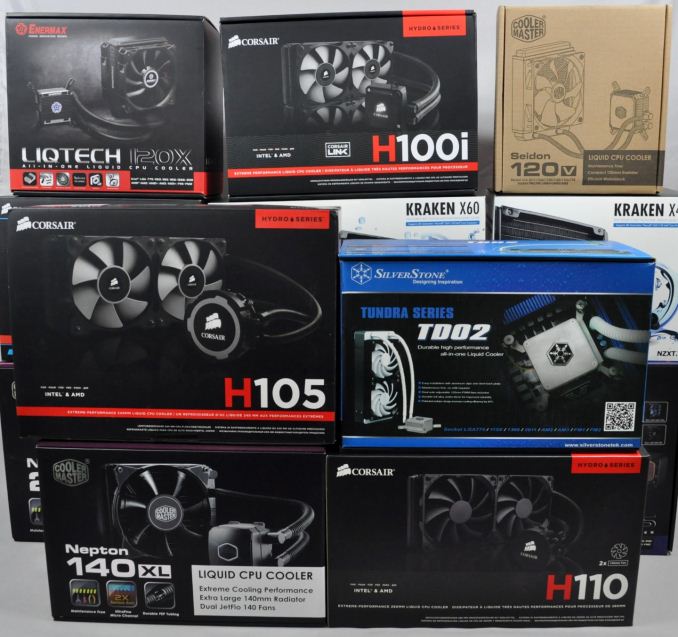Closed Loop AIO Liquid Coolers: 14-way Mega Roundup Review
by E. Fylladitakis on February 12, 2014 7:00 AM EST
Remember the time when liquid cooling a computer chip was considered to be an extreme approach, one performed by hardcore enthusiasts and overclockers alone? Everything had to be personally designed and or procured by the user, as there were no specialized commercial products available at the time. Radiators were modified heater cores extracted from cars, CPU blocks were rare and occasionally machined at local workshops using a copper block and a lathe, while high-performance tubing came from shops with medical supplies.
As demand grew, aided by the ever-increasing noise of small CPU heatsinks, companies specializing on liquid cooling solutions began turning up -- a little too fast perhaps, as tens of companies were founded within a few months' time and very few of them actually survived for more than a couple of years. Enthusiasts could then buy specialized liquid cooling equipment and even whole kits from just one seller and only had to assemble the setup into their system. That of course is no simple process for an amateur and a nightmare for a system builder, who cannot ship a system with a topped off water cooling tank or assume that the user has the skills required to maintain such a system, therefore the potential market remained limited to advanced users only.
This all changed in 2012, when Asetek came up with an inexpensive closed loop solution, a liquid cooling device that was leak-free and required no maintenance at all. The radiators of the first few solutions were small and their overall performance hardly better than that of air coolers; however, aided by the modernization of computer cases, the mounting of larger, thicker radiators inside a PC soon was not a problem. In many cases the kits were now no harder to install than any CPU cooler and required no maintenance at all, opening the market to virtually every computer user seeking a performance cooling solution. This spurred massive interest amongst OEMs and manufacturers, who all strive for a slice of the pie.
There have been tens of AIO (All-in-One) closed loop liquid coolers released just in 2013; today, we are having a roundup with 14 of them, coming from five different manufacturers, alphabetically listed in the table below.
| Product | Radiator Effective Surface | Radiator Thickness | # of Fans (Supplied / Maximum) | Speed Range of Supplied Fans (RPM) | Current Retail Pricing |
| Cooler Master Seidon 120V | 120mm × 120mm | 27mm | 1 / 2 | 600-2400 | $49.99 |
| Cooler Master Nepton 140XL | 140mm × 140mm | 38mm | 2 / 2 | 800-2000 | $99.99 |
| Cooler Master Nepton 280L | 140mm × 280mm | 30mm | 2 / 4 | 800-2000 | $119.99 |
| Corsair H75 | 120mm × 120mm | 25mm | 2 / 2 | 800-2000 | $69.99 |
| Corsair H90 | 140mm × 140mm | 27mm | 1 / 2 | 600-1500 | $84.99 |
| Corsair H100i | 120mm × 240mm | 27mm | 2 / 4 | 800-2700 | $109.99 |
| Corsair H105 | 120mm × 240mm | 38mm | 2 / 4 | 800- 2700 | $119.99 |
| Corsair H110 | 140mm × 280mm | 29mm | 2 / 4 | 600-1500 | $126.99 |
| Enermax Liqmax 120S | 120mm × 120mm | 32mm | 1 / 2 |
600-1300 600-2000 600-2500 (Multi-range) |
$163.00* |
| Enermax Liqtech 120X | 120mm × 120mm | 43mm | 2 / 2 |
600-1300 600-2000 600-2500 (Multi-range) |
$171.10* |
| NZXT Kraken X40 | 140mm × 140mm | 27mm | 1 / 2 | 800-2000 | $89.99 |
| NZXT Kraken X60 | 140mm × 280mm | 27mm | 2 / 4 | 800-2000 | $119.99 |
| Silverstone Tundra TD02 | 120mm × 240mm | 45mm | 2 / 4 | 1500-2500 | $118.99 |
| Silverstone Tundra TD03 | 120mm × 120mm | 45mm | 2 / 2 | 1500-2500 | $97.99 |
*The coolers from Enermax are not widely available in the USA at the time of this review, with the only viable option appearing to be that of import from Asia or Europe.
Although Asetek was the first to come up with the design and they hold patents for it, they are not the only OEM of AIO cooling solutions today. At least three different OEMs are behind the kits listed in the table above. We will have a closer look at each one of them in the following pages.











139 Comments
View All Comments
lwatcdr - Thursday, February 13, 2014 - link
And maybe the CoolerMaster Evo 212Streetwind - Wednesday, February 12, 2014 - link
Excuse me for pointing this out, but are the noise levels given here not a little bit bogus? On your "Testing Methology" page, you qualify 50-54 dB(A) as "Extremely loud (level equivalent to a ≈1500W vacuum cleaner)". Then on the next page in your 12V results, you state: "To give you a rough estimate, 56 dB(A) represents about the same level of sound as a typical box fan the same distance."Are you honestly trying to imply that a CPU fan is capable of producing a typical noise scenario that is twice as intense as a 1500W vacuum cleaner at full bore? I think that either the table under "Testing Methodology" is wrong, or you performed your tests in a way that generates results which have absolutely nothing whatsoever to do with the scale presented in the table. In both cases, said table is in dire need of a revision.
The article is very nice and no doubt took a lot of work, but with the noise levels looking as arbitrary as they do, it's very difficult to glean much value from it other than a rough order of absolute cooling performance. There's no noise floor given either, and no qualifying comparison to an air cooling solution.
E.Fyll - Wednesday, February 12, 2014 - link
That is my error. The original sentence was something along the lines of "To give you a rough estimate, 56 dB(A) represents about the same level of sound as a small vacuum cleaner over the same distance". I was then told that vacuum cleaners in the US are generally larger and much louder than their counterparts here and that the comment was edited, but I foolishly did not check the article. 56dB(A) is definitely loud, as much as two of the loudest 140 mm fans, although not as loud as a vacuum cleaner; at least not the kind of vacuum cleaners most readers here are used to. :) More like to the noise of a small hair dryer, I suppose.LancerVI - Wednesday, February 12, 2014 - link
Thanks for the explanation. When I heard "as loud as a vacuum cleaner" I was taken aback. Our vacuums are LOUD! My custom WC loop is loud, but it's no where near vacuum cleaner loud.Impulses - Thursday, February 13, 2014 - link
Now I'm intrigued by these stealthy Euro vacuum cleaners... :p3DoubleD - Thursday, February 13, 2014 - link
Me too... please review!svandamme - Tuesday, December 2, 2014 - link
take it from me , they suckConnoisseur - Wednesday, February 12, 2014 - link
It would be great to see a quiet system builder's guide with different components and form factors. My holy grail has always been a mid-upper range miniITX gaming system that's virtually silent 90% of the time. Something with a core i5 or i7 CPU and R9 270x or GTX 760 stuffed into a small case with quiet operation. Probably doesn't exist yet but one can always hope :)w1z4rd - Monday, February 17, 2014 - link
I'm running a 4770k on an Asus Maximus VI Impact with a Corsair h100i and an EVGA GTX770 in a Corsair 250D that's sitting on my desktop. Unless I'm gaming I can't hear the thing. I don't hear it when gaming either, actually, as I have a headset on.Navvie - Wednesday, February 12, 2014 - link
Ever think about asking Mike Chin at SPCR to do some noise testing for you?